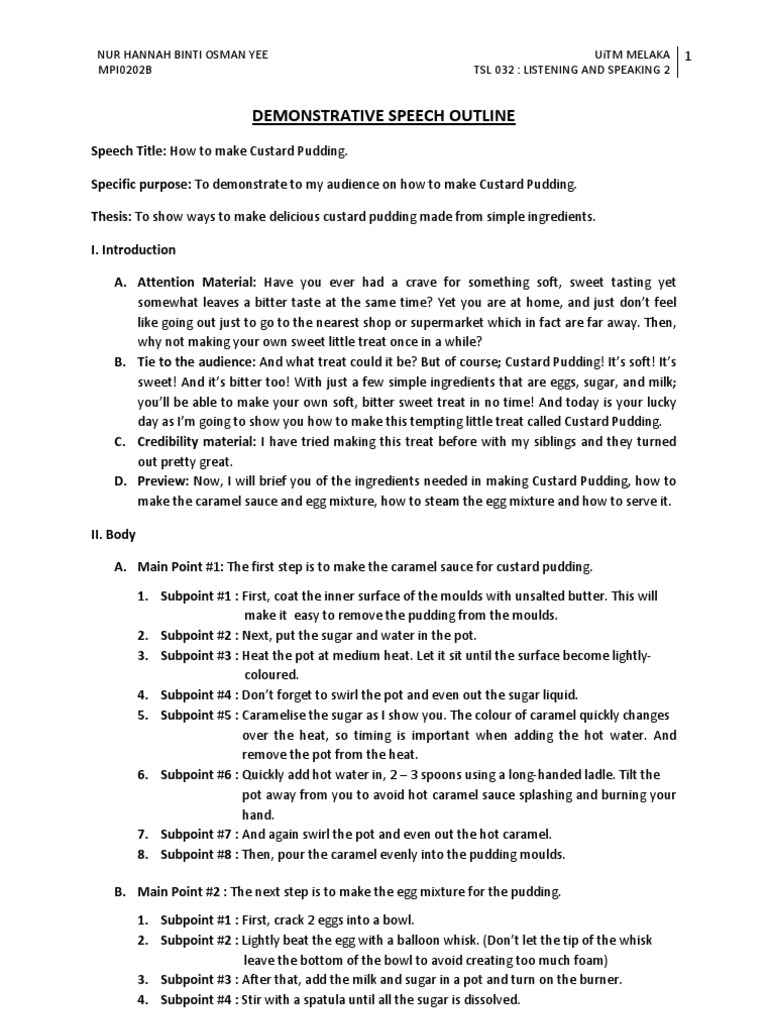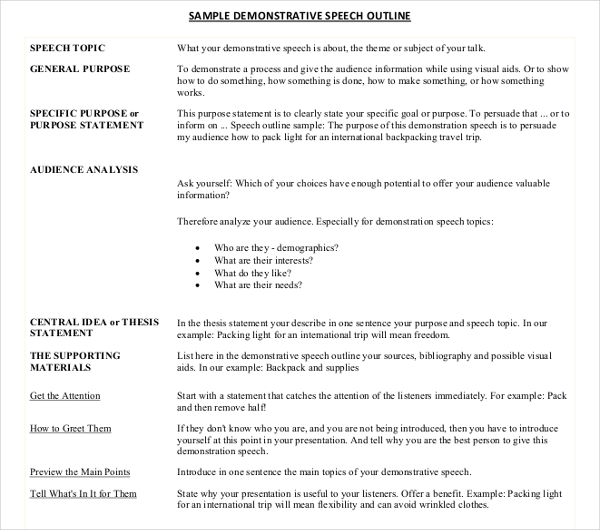
Nov 14, · Demonstrative. This has many similarities with an informative speech but it also teaches you to do or perform something. A cooking demonstration is a good example of this kind of speech which instructs the audience on how to do something step by step. Have you gone to big malls where they demonstrate how to arrange flowers or to decorate cakes Direct speech: I said, “I do my homework.” Reported speech: I said that I did my homework.; Direct speech: We said, “we buy our clothes.” Reported speech: We said that we bought our clothes.; Rule #3. Second person pronoun in direct speech (i.e. you) is changed according to “object” of reporting verb. For example: Direct speech: He said to her, “you are cute These descriptive adjectives will have you well on your way to spicing up your writing. Browse this list, from simple to compound, to sprinkle into your work
Grammar: Demonstratives (This, These, That, Those)
A pronoun is a word that replaces a noun in a sentence. Using pronouns keeps you from repeating the same nouns over and over again. There are many different types of pronouns, each serving a different purpose. Keep reading for the different types of pronouns that you're likely to encounter in your reading and conversations.
Personal pronouns function as a substitute for a person's name. Subject pronouns replace the name of the subject of a sentence, while object pronouns replace the name of the object. The main personal pronouns are:.
The personal pronouns you use depend on many things, including the context of a sentence and a person's preferred pronouns. Possessive pronouns show ownership or possession of a noun. They replace a noun that typically has an apostrophe and "s" after it such example of demonstrative speech "Bethany's". There are two types of possessive pronouns: possessive determiners that can function as pronouns, and independent possessive pronouns, which refer to a previously stated noun.
Notice that the possessive determiners always come before a noun, while the independent possessive pronouns can stand alone. Example of demonstrative speech two possessive pronouns that are the same in both cases are his and its — the words are spelled the same no matter how you use them as a pronoun with no apostrophe in its. Indefinite pronouns don't point to particular nouns. We use them when an object doesn't need to be specifically identified. There are singular indefinite pronouns that function as singular nouns, and plural indefinite objects that function as plural nouns.
There are also some indefinite pronouns that example of demonstrative speech both ways. Most indefinite pronouns work whether the noun comes before the pronoun or not. However, clarifying the noun in the previous sentence may help with any misunderstanding. Relative pronouns connect a clause or phrase to a noun or pronoun. We often see them when we need to add more information.
They also include indefinite relative pronounswhich are relative pronouns with "ever" at the end. You can use relative pronouns to introduce adjective clauses. They connect dependent clauses to independent clauses to create a more thorough sentence. Interrogative pronouns have the same form as relative pronouns, but they ask a example of demonstrative speech. Some people confuse interrogative pronouns with interrogative determinerswhich come before a noun.
However, like all pronouns, interrogative pronouns must replace a noun. It may seem like there are words missing from this list, such as where and why. However, they are not interrogative pronouns — they are adverbs that describe more about verbs. Reflexive pronouns replace the object of example of demonstrative speech sentence when it refers to the same person or item in the subject.
They usually follow the verb in the sentence, but can also follow a preposition, example of demonstrative speech. These pronouns end in -self singular reflexive pronouns or -selves plural reflexive pronouns. If you replace these pronouns with the nouns in the sentence, they are still correct, but they're more awkward. Intensive pronounsalso known as emphatic pronouns, emphasize or intensify nouns and pronouns. They take the same form as reflexive pronouns, but unlike reflexive pronouns, they're not essential to the sentence.
You usually find them right after the noun they're intensifying. If you remove intensive pronouns from the sentence, it still makes sense. However, intensive pronouns help to emphasize the important example of demonstrative speech of the sentence, so they are still helpful to include. Demonstrative pronouns take the place of a noun that's already been mentioned. Demonstrative pronouns can be singular or plural. There are five of them, and example of demonstrative speech can also function as demonstrative adjectives.
Demonstrative pronouns can also function as demonstrative adjectives. For example, in the sentence "Neither fits me," neither is functioning as a pronoun. If you add example of demonstrative speech noun into the sentence, such as "Neither dress fits me," neither now functions as an adjective that describes the dress. Reciprocal pronouns show an action that two or more nouns are performing together. There are only two reciprocal pronouns, but they play a big role in English.
They also aren't used in the same way. Punctuating reciprocal pronouns can be tricky for some people. When you're using each other or one another as a possessive pronoun as in "We opened each other's presents"treat it as a singular noun and add an apostrophe and "s," not an "s" and apostrophe as you would with a plural possessive noun. Now that you know all the different types of pronouns, practice using them!
Check out these helpful resources for reinforcing pronoun skills in your writing. Pronouns are multi-taskers, working busily to point us in different directions.
They free us from the catastrophe of repeated nouns. Learn more about the different parts of speech in your writing journey. You can also practice your noun know-how with a helpful noun quiz to test your knowledge, example of demonstrative speech.
Sign in with Google Dictionary Thesaurus Sentences Examples Knowledge Grammar Biography Abbreviations Reference Education Spanish More About Us Contact Us Suggestion Box Privacy Policy Cookie Settings Terms of Use © LoveToKnow Media.
Example of demonstrative speech rights reserved. Word Finder 4 Pics 1 Word Answers Anagram Solver Scrabble Dictionary Unscramble Words with Friends Cheat. Home Grammar Types of Example of demonstrative speech Types of Pronouns. types of pronouns examples written on chalkboard. Personal Pronouns Personal pronouns function as a substitute for a person's name. The main personal pronouns are: Subject Pronouns I, example of demonstrative speech, you, he, she, it, we, they I don't want to leave.
You are a talented artist. They went to the store. Object Pronouns me, you, her, him, it, us, them Go talk to her. Has anyone met him? Come sit with us. Possessive Pronouns Possessive pronouns show ownership or possession of a noun. Possessive Determiners my, your, example of demonstrative speech, our, her, his, its, their Is that my book? Your dog is so cute. Her job is exciting. Independent Possessive Pronouns mine, yours, ours, hers, his, its, theirs That prize is mine.
Ours is down the street. The decision is theirs. Indefinite Pronouns Indefinite pronouns don't point to particular nouns. Singular Indefinite Pronouns anybody, anyone, anything, each, everybody, everyone, everything, little, much, nobody, no one, nothing, one, somebody, someone, something Everybody loves it here. Nothing is too hard. One must consider the possibilities. Plural Indefinite Pronouns both, few, many, several Both sound good to me. Few have mentioned it. Many offered to help, example of demonstrative speech.
Singular and Plural Indefinite Pronouns all, any, more, most, none, example of demonstrative speech, some, such All are welcome. More can fit at the table. Can you bring some? Relative Pronouns Relative pronouns connect a clause or phrase to a noun or pronoun. Relative Pronouns who, whom, which, whose, that Find the man who stole the money. The dog, which barked all night, is asleep. I sold the watch that my sister gave me. Indefinite Relative Pronouns whoever, whomever, whichever, whatever Thank whoever sent a gift.
Whichever you choose will be great. We should take whatever train comes next. Interrogative Pronouns Interrogative pronouns have the same form as relative pronouns, but they ask a question.
Interrogative Pronouns who, whom, which, what, whose Who is absent? Which is cheaper? Whose is this? Other Interrogative Pronouns whoever, whomever, example of demonstrative speech, whichever, whatever Whomever should I call?
Whichever did you want? Whatever do you mean? Reflexive Pronouns Reflexive pronouns replace the object of a sentence when it refers to the same person or item in the subject.
Demonstrative Speech: Emergency Kit
, time: 5:14Changes of Pronouns in Reported Speech: Rules & Examples • 7ESL

Direct speech: I said, “I do my homework.” Reported speech: I said that I did my homework.; Direct speech: We said, “we buy our clothes.” Reported speech: We said that we bought our clothes.; Rule #3. Second person pronoun in direct speech (i.e. you) is changed according to “object” of reporting verb. For example: Direct speech: He said to her, “you are cute These descriptive adjectives will have you well on your way to spicing up your writing. Browse this list, from simple to compound, to sprinkle into your work When it comes to types of pronouns, you should be familiar with what they look like and how they're used. Learn everything you need to know with this guide
No comments:
Post a Comment